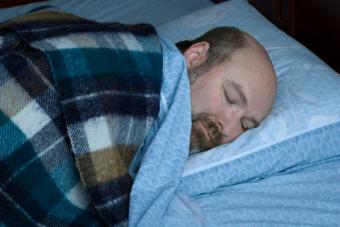
For those experiencing night terror symptoms, getting medical help will not only improve an individual's ability to sleep, but also their quality of life. Night terrors, medically termed Pavor Nocturnus and sometimes called sleep terror disorder, are a clinically-diagnosed sleep disorder. In this condition, the individual suffers a sudden, very fearful episode in their sleep. They are in a terrified state, although no noticeable reason for being in this condition exists.
Night Terrors Symptoms
Those who experience night terrors often have no idea what is happening to them or why. At first, many believe their condition is nothing more than a bad nightmare they cannot remember. Yet, the condition can become more frequent and disrupt the quality of life when left untreated. Knowing the symptoms of night terrors is a good place to start:
- Suddenly waking up
- No recollection of bad dreams or nightmares
- Strong level of fear or terror
- A fear to go to sleep, associating sleep with terror
- Screaming when waking, not knowing why the screaming is happening
- Rapid heart rate
- Increased breathing
- Confusion
- No memory of the event the next day, during normal waking hours
- Sweating
- Impossible or difficult to comfort during an episode
- May remember the images experienced for a short amount of time
These symptoms are most likely to occur during the first third of the night, when the sleep cycle has the brain in the late stages of three and the beginning of stage four for the longest period of time. After this point, the amount of time spent in these two stages lessens and the REM sleep phases lengthen. Since night terrors happen most frequently during phases three and four, most people experience them during the first portion of the night.
Sleep terrors may last as long as thirty minutes, though most are shorter. After this amount of time, the individual drifts into deeper, more normal sleep.
Spotting Night Terrors in Children
Children between the ages of three and five are likely to experience night terrors. The condition is fairly common in children of this age. Later, in preadolescent boys particularly, the condition can return. As a parent, it can be hard to spot this condition, but knowing the most likely symptoms can be helpful:

- The child wakes up suddenly.
- The child is having an episode and the parent cannot communicate with them. They don't respond to touch or vocal instruction during this time.
- The child screams and may thrash around in bed. They appear to be frightened, though no signs of trauma or frightening conditions are found.
- After a few minutes, the child either drifts back to sleep or awakens and is responsive.
Most parents fear the worst during a night terror episode. Most children are not scared by or even remember the episode happening. Nevertheless, parents can and should respond to their child in this state as the child can awake frightened. In some cases, the child may become afraid to go to bed at night, especially if they remember any of the images during the night terrors.
Symptoms of Nightmares and Night Terrors
Know the difference between nightmares and night terrors. Nightmares happen during REM sleep. They are almost always a direct reflection of the individual's experiences including their emotional strain, stresses, and even watching a scary movie. The same is not true of night terrors.
In order to understand night terrors symptoms, it is important to know the difference between these two conditions. With night terrors, there may not be any circumstance that brings on the episode. Parents of young children experiencing night terrors may become overwhelmed with removing any frightening element from their child's wakeful hours in hopes of combating what they think are nightmares only to find the child is still experiencing frightful sleep periods. In these situations, it is common that the child is experiencing night terrors.
Getting Help
For those experiencing any of these symptoms of night terrors, the first step is to seek out help from the family doctor to ensure there is no complication or other sleep disorder affection the individual. In children, the individual often needs nothing more than reassurance and time to pass before they will stop experiencing the condition. In adults, there may be a need for psychotherapy and lifestyle changes.
.







